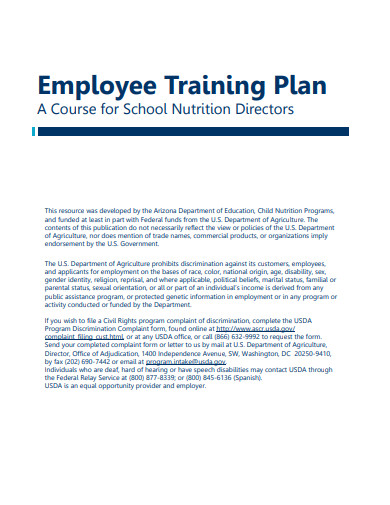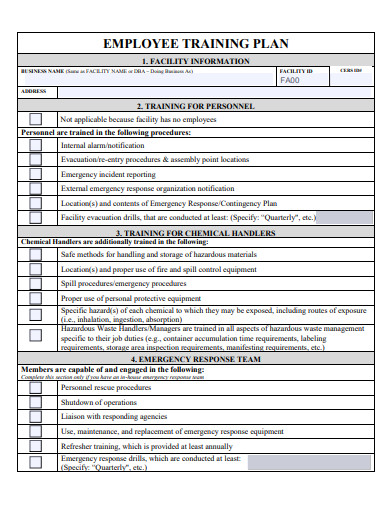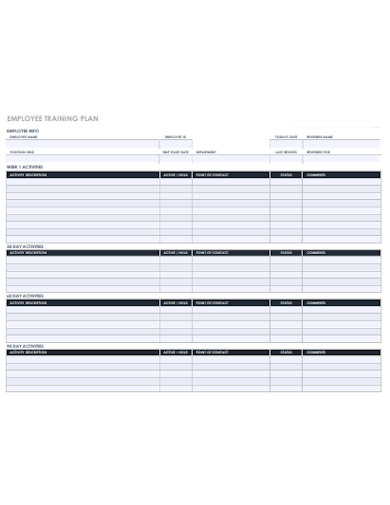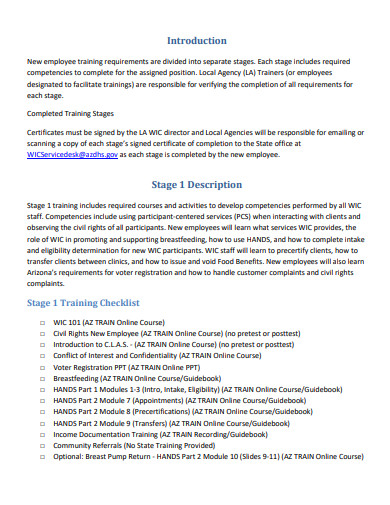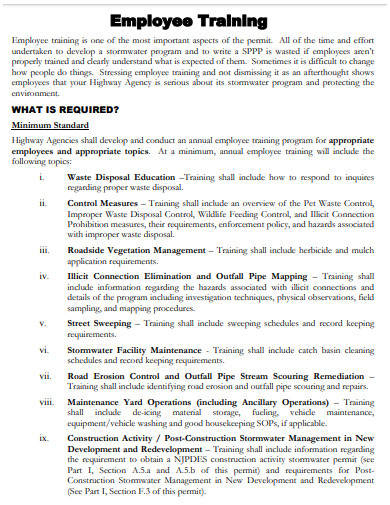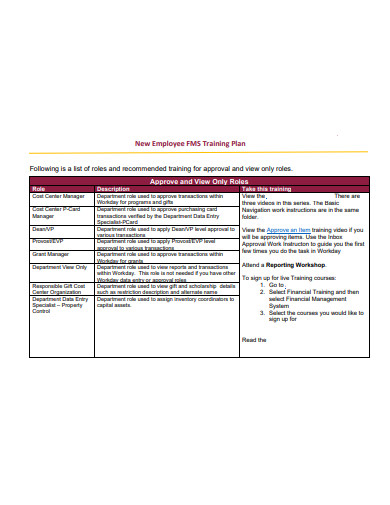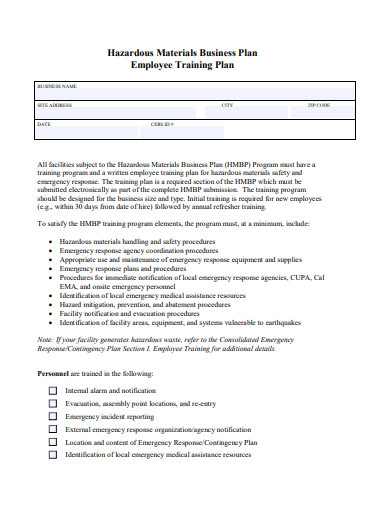10+ Employee Training Plan Examples to Download
Employee growth or employee development becomes mandatory to a company if it aims to improve its overall performance. They corporate training plans or work training plans that revamp the functionalities of an organization’s professional manpower. The said growth or development follows a training process that serves great importance to all employees, up from the management department down to the utility staff. Not only that, the processes of these employee training programs or employee workshops also come with effective metrics in the job orientation of new hires. If you wish to learn more about such documents, then you better check out our Free 10+ Employee Training Plan Examples in PDF, Microsoft Word, Google Docs, and Apple Pages file formats!
10+ Employee Training Plan Examples
1. Employee Training Plan
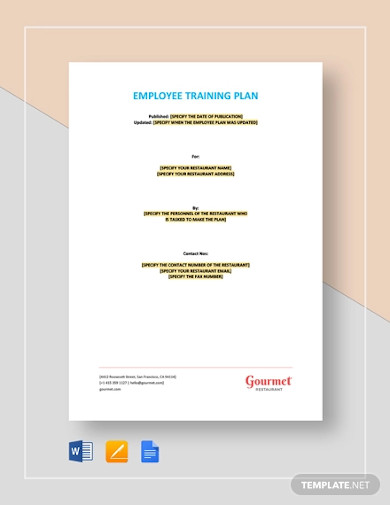
2. New Employee Training Plan
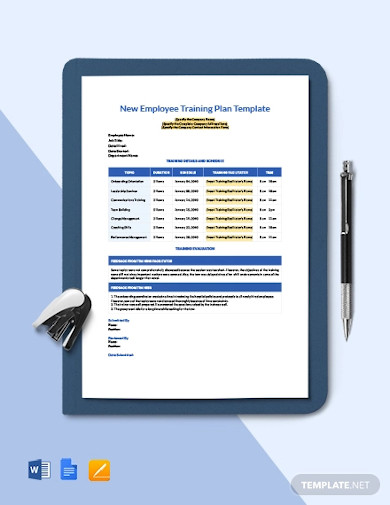
3. Software Employee Training Plan
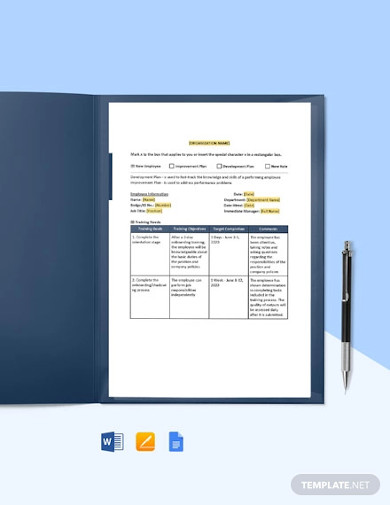
4. Company Employee Training Plan
5. Employee Training Plan Example
6. Employee Safety and Health Training Plan
7. Employee Training and Development Plan
8. New Employee Training Plan
9. Simple Employee Training Plan
10. Employee Sales Training Plan
11. Business Training Plan for Employee
What Is an Employee Training Plan?
An employee training plan is a proposition that involves activities and strategies that make way for the improvement of a particular employee or working group. In Kirstie Greany’s April 2020 blog for Elucidat, she highlighted that the plan contributes in the easy implementation of an employee engagement strategy, as well as in the amplification of employee retention. In addition, she wrote that careful and proper setting of the plan’s specifications can lead to the breakthrough of an organization’s innovation, efficiency, and productivity. With those facts presented, no wonder why almost every business has one in its training inventory and workshop inventory.
The Rise of Online Employee Training
We can’t deny that the digital age has successfully taken over the globe. And, many people are sure glad that it did. For businesses, the change made works or chores more convenient. A great example of that instance is the pieces of employee training that are now made accessible online. Unlike the conventional ones, this mode of teaching doesn’t need training itineraries. Thus, it suits perfectly to companies who would prefer economic alternatives. Some areas of training preparation still apply, like making a training list, a training letter, and a training memo.
How To Organize an Employee Training Plan
Organizing a training plan for your employees must be done in consideration of a lot of areas. However, knowing what these areas are is not enough. You also have to ensure that you have enough knowledge on the items that they involve, like characters, employee goal setting, employee assessment, activity schedules, presentations, and activity analysis. With your convenience in mind, we have created an outline that you can refer to. This is also to make sure that you get the aforementioned items on hand as you organize your employee training plan.
1. Determine Employee Character, Target, and Success Criteria
The first thing you have to do in organizing an employee training plan is to determine the subject employee’s character, your goals, and your success criteria. By knowing the very nature of your subjects, you made yourself aware of its statistical data, which are very important in modulating an appropriate syllabus. The corporate goals and the success criteria will act as determiners of your plan’s outcome.
2. Outline Training Activities
Creating a training outline helps you get a clear view of your employee training plan in a bigger picture. In line with it, an effective outline must highlight the important areas and points that you see fit for your training program. By preparing it ahead of time, you can smoothly detail all of your process document’s scope.
3. Write Down the Details and Prepare the Set of Activities
Once you have your outline ready, the next thing you have to do is to write down the details of every area and its corresponding points. Most importantly, you must not forget about the activities and their complementary training program schedules. The list of activities and their timeframe is the main purpose of the whole plan. Without them, the plan can’t proceed to the next phase, which is implementation.
4. Strategize Presentation
After the documentation of your employee training plan, it is time to present them to the subjects. But before sending out a memo or rushing into the training venue, there is a need for you to strategize your presentation. There is an art in engaging with an audience. So, learning and incorporating it into your demonstration is a must before facing your training subjects. Otherwise, your training program will be ineffective in integrating skills, knowledge, and experience.
5. Collect Scores and Assess Based on Criteria
Since the whole plan revolves around training, it is safe to assume that there were hands-on or written examinations involved. If so, then you must know that their examination scores or grades are necessary for the employee assessment, which should be based on the determined success criteria.
FAQs:
1. What are the types of corporate training?
According to Corporate Training Solutions (CTS) Vietnam, there are five types of corporate training. These include leadership and management development, customer and client communications, workplace ethics and anti-harassment, English training program, and creative thinking program.
2. What are the different approaches to employee training?
TalentLMS cited that the employee training approaches consists of the following:
1. Instructor-led Training Approach – Face-to-face training and webinars
2. Active Training Approach – Workshops, case studies, and brainstorming sessions
3. Experiential Training Approach – On-the-job training, coaching sessions, role-playing, and simulations
4. Tech-Enabled Training Approach – eLearning, gamification, and microlearning
3. Who conducts training for employees?
Sergei Golubenko affirmed in his 2019 article for eLearning Industry that human resources workforce and operation supervisors should train employees hand in hand. Even though there are differences between the benefits that each of them brings, they still supplement one another in determining an organization’s training necessities and their suitable training programs.
The workforce is one of the major assets of a company. It is also one of the foundations that help businesses build up their corporate brand, profitability, and sustainability. Just as Aristotle’s famous quote, “The whole is greater than the sum of its part,” an organization has to keep in mind the employees’ morale, for they greatly contribute to the entire company. Aside from the compensation, an employee training plan is one good way to keep those morales up.



